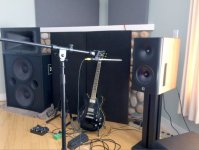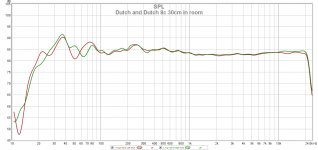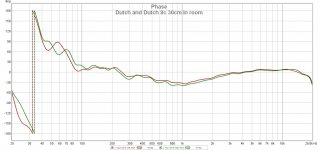I’ve been following the extremely positive response to the D&D 8c with great interest.
One of the more intersting features, IMHO, is the rear firing woofers. I believe these are intended to couple with the rear wall.
This seems to be a similar theory to the Lyngdorf boundary woofers, and others here such as Wayne from Pi audio... ie let the bass be handled by stereo woofers butted up against the front wall and eqed for response and delay.
I’ve been doing this for a while with my current speakers with good results, and I’m wondering how it can be improved.
One of the more intersting features, IMHO, is the rear firing woofers. I believe these are intended to couple with the rear wall.
This seems to be a similar theory to the Lyngdorf boundary woofers, and others here such as Wayne from Pi audio... ie let the bass be handled by stereo woofers butted up against the front wall and eqed for response and delay.
I’ve been doing this for a while with my current speakers with good results, and I’m wondering how it can be improved.
I feel there is more to it than just rear firing twin woofers against the wall. There is the dipole/cardioid mid, I believe it is the integration of this with the twin woofers which gives it the excellent polar plot very down low. By integration I mean to change phase/spl in the crossover region to achieve a narrow front radiation. Maybe has heavy FIR DSP to do it. I am not sure and can only contemplate.
It is a thing called "the Allison effect" see Langmuir Talk - Middle Part and Allison Effect - layman - Speaker Asylum
D&D make sure the dip is outside of the working range of the woofers.
The result is a very compact speaker with full range capabilities.
Combined with the cardioid mid, waveguide assisted tweeter and some personalized DSP, this will result in a very smooth frequency curve at the listeners ears.
IMO D&D showed us the future of high quality sound reproduction.
D&D make sure the dip is outside of the working range of the woofers.
The result is a very compact speaker with full range capabilities.
Combined with the cardioid mid, waveguide assisted tweeter and some personalized DSP, this will result in a very smooth frequency curve at the listeners ears.
IMO D&D showed us the future of high quality sound reproduction.
From what I gather having rear firing subwoofers for boundary bass response, requires a perfect step-response. This FIR filters are imperative.
From my understanding the response is omni-polar at this frequency so there will be multiple wave fronts; one from the driver as the wave wraps around to the fro to front of the cabinet and another from the wall reflection.
Perhaps they are close enough to not make a difference in the bass perception at the listening position? Is there narrow band cancellation in the measurements below 100hz ?
Perhaps they are close enough to not make a difference in the bass perception at the listening position? Is there narrow band cancellation in the measurements below 100hz ?
It's another "Allison effect"😀, F. Allison, not R. Allison.It is a thing called "the Allison effect" see Langmuir Talk - Middle Part
But thank you for this link 🙂, nice reading about Pathological Science.
I think for some true audiophiles it may be useful.
Last edited:
I'm curious how you think it can be improved, or what you think is wrong with it now, so suggestions can be made.
To some degree the boundary constraining and modal behaviour need to be viewed independently.
To some degree the boundary constraining and modal behaviour need to be viewed independently.
From my understanding the response is omni-polar at this frequency so there will be multiple wave fronts; one from the driver as the wave wraps around to the fro to front of the cabinet and another from the wall reflection.
Perhaps they are close enough to not make a difference in the bass perception at the listening position? Is there narrow band cancellation in the measurements below 100hz ?
Given the wavelengths involved, the gap between the back of the speaker and wall is small enough that the two sources (real and reflected) are essentially in the same place.
Chris
I see,
I wonder is the reflected bass wave close enough at that wavelength such that a digital delay between the subwoofers and midrange is not really required?
I wonder is the reflected bass wave close enough at that wavelength such that a digital delay between the subwoofers and midrange is not really required?
Dutch&Dutch aim for a cardioid response from 100Hz upwards.
They seem to be half way between how MEGeithain do it (fully passive) and the Kii 3 (fully DSP controlled with extra woofers that run out of phase with the main one.
This might help to explain it a bit better:Dutch & Dutch 8C
They seem to be half way between how MEGeithain do it (fully passive) and the Kii 3 (fully DSP controlled with extra woofers that run out of phase with the main one.
This might help to explain it a bit better:Dutch & Dutch 8C
Hi guys. Of all the online forums diyaudio is the one where I learned most of what I know about speaker design, acoustics and psychoacoustics. There are a lot of very smart and knowledgeable people here. Therefore I'm very pleased to see the 8c being discussed here.
Inspired by the work of Roy Allison, in the 8c we make use of boundary coupling. Boundary coupling and a couple of the other principles used have already been explained by others in several posts, but allow me to summarize.
A strong reflection causes a comb filter.

Comb filter delay time dips and peaks comb filters notch frequency - initial time delay gap ITDG - sengpielaudio Sengpiel Berlin
If the reflection happens very early - within a fraction of the period (T) - the direct sound and the reflection sum constructively and the combined result is minimum-phase. In the 8c we make use of this fact by coupling the woofers <100 Hz in the back with the front-wall. This works very well if the distance between the 8c and the wall is about 50 cm or less.
If you increase the distance to 85 cm (quarter wavelength), you get an on-axis null. The first comb filter notch. In practice you don't get a very deep dip, because at the crossover frequency of 100 Hz half of the sound is produced by the cardioid midrange. While the woofers make use of the front-wall for boundary coupling, for the cardioid it's as if the wall isn't even there.
There are three main benefits to using boundary coupling:
The cardioid works from 100 Hz up to several hundred Hz. It is completely passive. The backwave of the driver is delayed and filtered such that it cancels that part of the frontwave that wraps around the enclosure and is radiated towards the back. At higher frequencies directivity of the midrange remains very constant, because as the cardioid loses its effect new sources of directivity come into action, such as driver directivity and directivity as a result of edge diffraction. At 1250 Hz the tweeter with waveguide takes over. The waveguide is optimized for directivity and impuls response smoothness.
Hope that helps!
Inspired by the work of Roy Allison, in the 8c we make use of boundary coupling. Boundary coupling and a couple of the other principles used have already been explained by others in several posts, but allow me to summarize.
A strong reflection causes a comb filter.

Comb filter delay time dips and peaks comb filters notch frequency - initial time delay gap ITDG - sengpielaudio Sengpiel Berlin
If the reflection happens very early - within a fraction of the period (T) - the direct sound and the reflection sum constructively and the combined result is minimum-phase. In the 8c we make use of this fact by coupling the woofers <100 Hz in the back with the front-wall. This works very well if the distance between the 8c and the wall is about 50 cm or less.
If you increase the distance to 85 cm (quarter wavelength), you get an on-axis null. The first comb filter notch. In practice you don't get a very deep dip, because at the crossover frequency of 100 Hz half of the sound is produced by the cardioid midrange. While the woofers make use of the front-wall for boundary coupling, for the cardioid it's as if the wall isn't even there.
There are three main benefits to using boundary coupling:
- increased output (+6 dB relative to free standing);
- improved directivity matching between the cardioid midrange and woofers; and
- subjectively tighter bass, presumably because of the cleaner first arrival wavefront.
The cardioid works from 100 Hz up to several hundred Hz. It is completely passive. The backwave of the driver is delayed and filtered such that it cancels that part of the frontwave that wraps around the enclosure and is radiated towards the back. At higher frequencies directivity of the midrange remains very constant, because as the cardioid loses its effect new sources of directivity come into action, such as driver directivity and directivity as a result of edge diffraction. At 1250 Hz the tweeter with waveguide takes over. The waveguide is optimized for directivity and impuls response smoothness.
Hope that helps!
Last edited:
Great to see someone from Dutch & Dutch posting. As far as speaker design goes, the 8Cs do a lot of things right, and I'd love to hear them. Unlikely to be any time soon with the collapse of the events industry, but hopefully I'll have some money in the near future.
Anyway, a question: were compression drivers considered for the HF region?
In my experience they have a lot of "pros" which make them particularly suited to the large-format midbass you're using here. CDs have much greater output capability than domes, which is especially pertinent for running down to 1250Hz, and the options for directivity control are a bonus.
TIA,
Chris
PS - the link in your signature (to the PDF of the 8Cs) throws a 404 error, and might need to be updated.
Anyway, a question: were compression drivers considered for the HF region?
In my experience they have a lot of "pros" which make them particularly suited to the large-format midbass you're using here. CDs have much greater output capability than domes, which is especially pertinent for running down to 1250Hz, and the options for directivity control are a bonus.
TIA,
Chris
PS - the link in your signature (to the PDF of the 8Cs) throws a 404 error, and might need to be updated.
I just noticed that there is a patent for the 8C. How is this possible considering these cardiod principles have been around for a long time? As well as applications round the Allison effect. Or were they just the first to patent it? Does the Kii 3 have a patent also? It would be nice to see this tech filter down at some point but also respect the research that is involved in such a project and the protection of ideas and solutions is important...but still
Protection by patent is complex, and it depends where the patent is registered and so on.
Quite often it has nothing to do with something you "found out" and wish to be "protected" (intellectual property).
In USA for example it has nothing to do with "intellectual" protection but more to prevent others to make profit of what you "found out".....question of who has the deepest pocket to pay the lawyer...
Indeed, there is not much in audio which has not already been described or "patented".
Quite often it has nothing to do with something you "found out" and wish to be "protected" (intellectual property).
In USA for example it has nothing to do with "intellectual" protection but more to prevent others to make profit of what you "found out".....question of who has the deepest pocket to pay the lawyer...
Indeed, there is not much in audio which has not already been described or "patented".
Check out my review of the 8c's with measurements: Dutch & Dutch 8c Loudspeaker Review
It is pretty cool to see (hear) how the rear facing subs leverage the front wall and add in phase with the rest of the system. See attached. Measured using REW's default 500ms window (i.e. no gating).
It is pretty cool to see (hear) how the rear facing subs leverage the front wall and add in phase with the rest of the system. See attached. Measured using REW's default 500ms window (i.e. no gating).
Attachments
- Home
- Loudspeakers
- Multi-Way
- Boundary woofers and Dutch & Dutch


